Doubling the antenna numbers would certainly help, & that there's interest in improving the performance of the range & signal strength over the stock RC controller, seems to be the point of this entire topic thread.
Also, the AlienTech Duo 2 product isn't the only 1 out there, advertising to address these concerns.
nolimitdronez.com with their product description:
No Limit Dronez 2.5W Signal Booster Board
The NLD 2.4GHz 5.8GHz dual-band bi-directional signal booster with automatic switching is a highly efficient and compact circuit board designed to increase the performance and range of transceivers working in the 2.4GHz and 5.8GHz ISM bands.
You can use the booster kit with DJI drones or any device that uses these frequency ranges, including but not limited to drones produced by companies other than DJI
_______________________________________________________________________________________________________________
But, I did notice this important distinction re: the difference between these 2 products:
“Booster Board Myth Busters
Power usage for the booster boards in the Aircraft
There has been criticism that the boosters will reduce flight time excessively.
The capacity of a
Mavic 2 battery is 3850 mAh. For a flight time of 30 minutes, the aircraft is therefore consuming 7700
mA on average. Assuming 1200
mA, the introduction of the booster board will reduce flight time by an estimated 15%
BUSTED”
_______________________________________________________________________________________________________________
With the
Mini 3 Pro Plus battery having the same capacity rating as the 1 mentioned in the above quote, DJI's stated “theoretical” maximum of a 47-minute flight time, with that additional ~6W power draw from the Plus battery in the
Mini 3 Pro, by my admittedly quick, rough & likely flawed calculations – Please, feel welcome to correct me if I'm in error here – that would seem to reduce that 47 minute flight time down to ~28 minutes.
I suppose that there would be situations where a
Mini 3 Pro pilot might be willing to trade off maximum flight time for signal strength from both ends – the RC controller & the drone – with all the above in consideration, at this point, if & when I make a decision to purchase 1 or the other, I'd lean to the AlienTech Duo 2 product.












